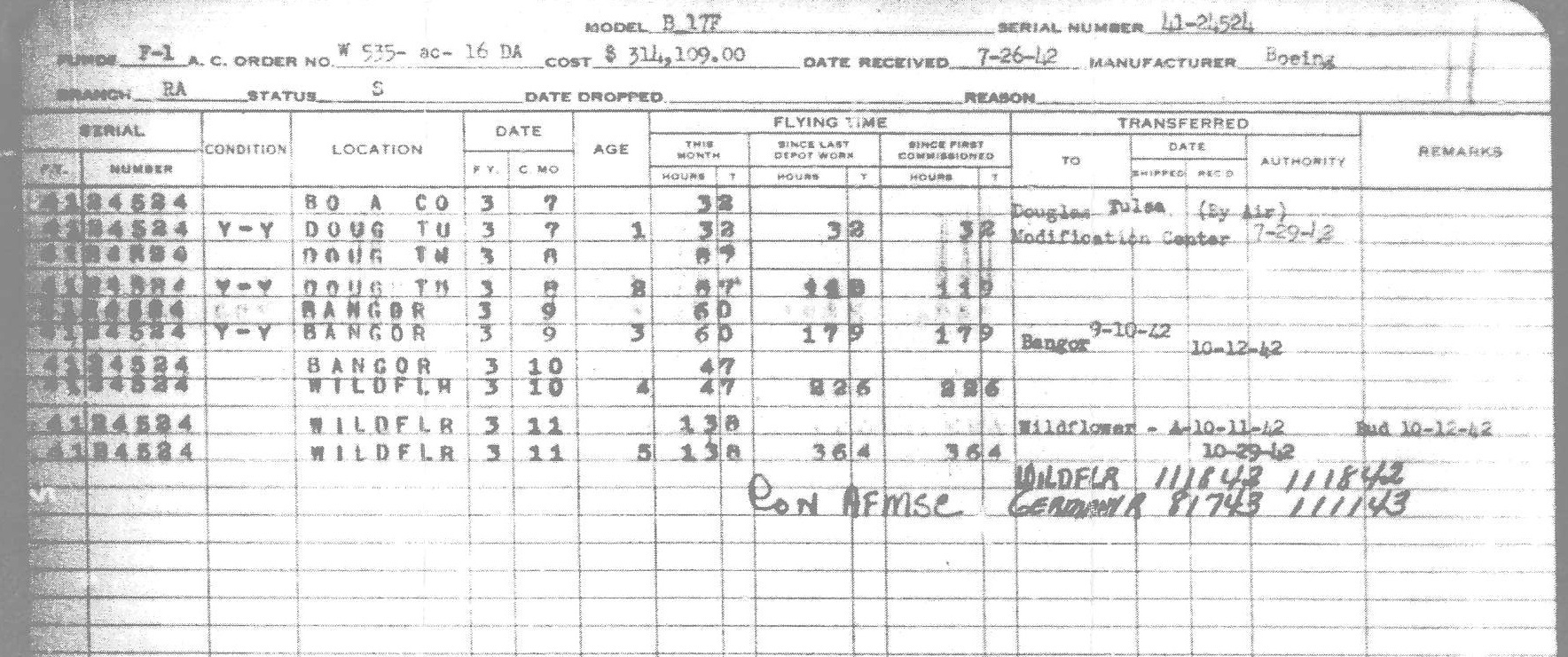Bomber crash August 17, 1943 – Harxheim escapes disaster
On the return flight from a heavy American double attack on Schweinfurth and Regensburg, a heavily hit American bomber of the type B-17F crashed into the Harxheim area. Of the 10 crewmen, two died, three others are considered missing, and five crewmen became German prisoners.
Beginning in wartime 1943, the Americans conducted more heavy air raids from England on southern Germany to hit the armaments industry based there.
The Americans relied on the defensive capabilities of their Flying Fortresses (four-engine U.S. long-range B-17F bombers) used in this effort. Therefore, these attacks – like the one on Tuesday, August 17, 1943 – were carried out by the U.S. Air Force (USAAF) without escort by American fighter planes over Reich territory. A double attack on Regensburg (aircraft construction) and Schweinfurt (roller bearings) by the 8th USAAF that day over Rheinhessen resulted in particularly heavy losses for the unit targeting Schweinfurt. This was decimated by German fighter pilots on the outbound and return flights by 36 aircraft.
Hans Kessel from Harxheim, then a boy of eleven, still remembered that summer day clearly:
The burned-out wreckage of First Lieutenant Arcaro’s B17-F. On the tail unit, the last three numbers (…524) of the identification are clearly visible. August 1943
Image source: Siegfried Schäfer
“It was around 2:00 p.m. when a burning four-engine U.S. bomber with a deafening noise, coming in a steep descent from the direction of Mainz, passed over Harxheim in the direction of Mommenheim and disappeared from view. In the Untergasse, the blast wave of the low overflight caused some window panes to break. A loud bang followed, then silence. A rising cloud of smoke signaled the crash. The news spread through the town like wildfire. Some older men as well as some men released from military service and many children immediately rushed to the crash site, which was located in the Im Bellenklauer parcel, i.e. about halfway between the churches and today’s Glockwieserhof. The bomber had broken into several pieces and was on fire, on-board ammunition began to explode. Because of the steep angle of the crash, some of the aircraft parts had dug deep into the farmland soil.”
Hans Bach, who is the same age, has the following to say about the whereabouts of the crew:
“Of the ten crew members, two were dead. Only the remains of the pilot could be recovered from the wreckage. Another American lay dead on a field several hundred meters further in the direction of Harxheim. His parachute had not been able to open due to the too low jump height.”
Mayor Adam Böhm prevailed against the intention of some angry “Volksgenossen” to deny the two U.S. soldiers a dignified burial. The dead were then buried in the Harxheim cemetery, to the left of the entrance way to the Catholic church.
Aircraft history card of the B-17F with serial number 41-24524, manufacturerBoing. This file card shows locations and control dates of the aircraft between July and October 1942 in the USA. The production cost of the bomber is valued at $314,109.00.
Source: Smithsonian National Aircraft and Space Museum, Archives Division; letter dated 03 Aug 2018, microfiche.
Hans Kessel added that another American crew member landed with his parachute on a shed roof in Bahnhofstraße, in the backyard of the Kohn family’s property. A young man who was driving the threshing machine in use that noon captured the American, who was uninjured but badly frightened, and was hailed as a hero for his action. The U.S. parachute was laid out in the courtyard of Böhm Bakery for display purposes. Another four crew members were also captured. After interrogation by Mayor Adam Böhm, the five Americans were led to Bodenheim by four soldiers from the anti-aircraft searchlight position located in the direction of Mommenheim Auf dem Türkelstein. Three other crew members of the B-17F piloted by First Lieutenant Anthony Arcaro were considered missing in action, according to Harxheimer witnesses. “Lucky were the Harxheimers!” said Hans Kessel thoughtfully, “if the pilot hadn’t pulled the badly damaged bomber up again, the plane would have crashed right into the middle of the village!”
In the commemorative publication for the 50th anniversary of the TuS Gau-Bischofsheim in 1972, it is reported that on August 17, in connection with the bomber crash in Harxheim, another crew member landed by parachute in Gau-Bischofsheim in the courtyard of the Zimmermann restaurant on the corner of Bergstraße/Langstraße. It is highly likely to have been one of the three missing crew members. There is no information about his further fate.
Shortly after the end of the war, a U.S. commission visited Harxheim and had the dead crew members exhumed for transfer to an American cemetery of heroes. Mayor Böhm was summoned by U.S. military authorities in Darmstadt in late 1945 and questioned in detail about the treatment of the crew and the burial of their dead comrades. The Americans credited him with his humane behavior.
The photo of the wreckage of the B-17F and crash site was given to the Bach family by an Air Force soldier deployed on the Türkelstein as a memento of the crash. The soldiers of the flak searchlight unit stationed there were regularly catered for by Harxheim and Mommenheim families in the absence of their own field kitchen.
References:
Leiwig, Heinz (2002): Flieger über Rheinhessen: The Air War 1939-1945. Alzey. 48-49
Light, Hans (undated). Chronicle of the municipality of Harxheim.
Turn-und Sportverein 1922 Gau-Bischofsheim e.V. (1972): Festschrift zum 50jährigen Bestehen des Turn- und Sportverein 1922 Gau-Bischofsheim e.V.. Gau-Bischofsheim.
Eyewitness interviews and reports between 2016 and 2021, own research
Related Articles
Field names
"Flurnamen (...) are names for agriculturally used areas (fields, meadows, vineyards, fallow land, etc.), community-owned facilities (bakehouse, gallows) and natural objects (forest, paths), which are located outside of settlements" (Flurnamen - namensforschung.net)....
Old Mommenheimer Street
Harxheim field name1 "IN THE HAMMER" (probably 17th c.) The name for this field designation could be derived from the hammer-like shape of the terrain at that time or from the Middle High German word "hamel" ([steile] height), because the terrain clearly rises to the...
Küchelbergweg
Harxheim field name1 "IN THE BEAN MORNING"The local field name "Im Bohnenmorgen" possibly refers to the word Bogen, which can easily become "bohne" in dialect. The corridor the size of an acre is then designated according to the shape of the terrain. However, perhaps...



